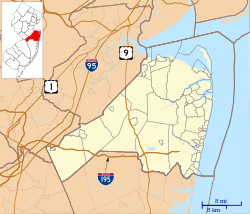Fort Hancock and the Sandy Hook Proving Ground Historic District | |
 | |
| Location | Sandy Hook, New Jersey |
|---|---|
| Coordinates | 40°26′41″N73°59′44″W / 40.44472°N 73.99556°W |
| Area | 4,584 acres (1,855 ha) |
| Built | 1859 |
| Built by | United States Army |
| NRHP reference No. | 80002505 [1] |
| NJRHP No. | 2024 [2] |
| Significant dates | |
| Added to NRHP | April 24, 1980 |
| Designated NHLD | December 17, 1982 [3] |
| Designated NJRHP | October 3, 1980 |
Fort Hancock and the Sandy Hook Proving Ground Historic District is a National Historic Landmark District that includes Fort Hancock and the Sandy Hook Proving Ground on Sandy Hook in Middletown Township, Monmouth County, New Jersey, United States. The district was added to the National Register of Historic Places on April 24, 1980 and designated a National Historic Landmark on December 17, 1982. [1] [3] It is part of Gateway National Recreation Area, administered by the National Parks of New York Harbor office of the National Park Service.


